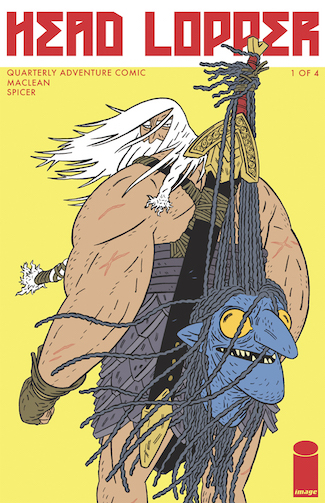Thursday Comics Hangover: Hey, kids! Head Lopper!

(Every comics fan knows that Wednesday is new comics day, the glorious time of the week when brand-new comics arrive at shops around the country. Thursday Comics Hangover is a weekly column reviewing some of the books I pick up at Phoenix Comics and Games, my friendly neighborhood comic book store.)
In nerd vernacular, the phrase “Hey, kids! Comics!” has taken on a couple of disparate meanings. It originated as a sign on the top of drugstore comics spinner racks (some iterations of the sign were paired with another sign that read “Wholesome entertaining comics”). The phrase has an earnestness to it that’s highly appealing, but it also smacks of a kind of charming hucksterism, not unlike the persona that Stan Lee would develop in early Marvel Comics letters pages.
Over time, though, the phrase has taken on a distinctly ironic flavoring. You’ll now most frequently find the phrase “Hey kids! Comics!” in comments sections, where fans will use it to mock too-gory or overly serious superhero comics. The first time I started seeing it with any frequency was around the time that writer Geoff Johns rose to ascendancy at DC Comics. Johns had a tendency to write comics in which B-list superheroes had their limbs torn off by villains, which annoyed people who liked to read comics to forget about things like violent dismemberment.
But the whole time I was reading the first issue of Andrew MacLean’s new self-described “Quarterly Adventure Comic” Head Lopper, the phrase “Hey, kids! Comics!” kept reverberating around my head like a pop song. Not in a bad way, mind you. The truth is, Head Lopper is the kind of comic that reminds me why I fell in love with comics in the first place. The action is too ridiculous for any movie CGI to convincingly capture and the premise is so cartoonishly simple — in ancient times, a large man with a sword travels around lopping heads off of people and creatures in exchange for money — that it allows a whole lot of artfulness to sneak in around the edges.
Here’s the story: Head Lopper (who is also known alternately as “Son of the Minotaur” or “The Executioner” or, as he prefers to be called, “Norgal”) has just lopped the head off a monstrous leviathan. Now he’s trying to collect payment for the deed. He’s double-crossed, of course, and so then he heads out in search of vengeance. Oh, and for some reason he has to carry around a severed witch’s head that won’t stop talking. (She shouts at Head Lopper early on, “Check your squinty eyes, oaf! I see, I hear, by Alba, I move!”) Head Lopper is a man of few words, a gigantic overstuffed couch of a barbarian, and so sometimes his tolerance for chit-chat flags.
Really, that’s about it. Head Lopper is just a story about a man who does a very specialized task — again, if you forgot already, he lops the heads off of his enemies — and happens to be very good at it. It’s a fantasy comic in much the same way that, say, Mike Mignola’s Hellboy is a fantasy comic. Head Lopper is not so much interested in deep Tolkien-ish world-building as it is in fun artistic challenges.
Most artists doing mainstream superhero comics should study these fight scenes; MacLean’s simplistic animation-style drawing is wonderfully fluid, and so a scene in which, say, Head Lopper fights a giant wolf, is easy to follow and it conveys a lot of information in an economical fashion. You can follow every step and slash that Head Lopper makes with his giant sword as he hops around the wolf’s enormous body, leaving strategic slices in his wake.
Many pages of Head Lopper pass by without dialogue, but MacLean crams his panels full of so much detail — the masonry of a child-king’s throne room, a stack of firewood piled up next to the front door of a home — that you can’t just mindlessly flip through the comic. There’s a lot going on under the surface of this silly story about a man who wanders around and fights monsters.
In the back pages of Head Lopper, MacLean explains why the book is coming out in huge hunks of fifty or sixty pages on a quarterly basis:
Here’s what I want in every issue of Head Lopper: long fights, dark jokes, creepy atmosphere, short plots and long plots, and comfortable conclusions that, hopefully, still leave you wanting more. The standard comic length would make me cut something short.
I agree; I wish more artists would experiment with this format. Head Lopper feels less like a brief installment in a larger story and more like a short novella that dips into a pre-existing fantasy world. It’s substantial and experimental and fun. In other words: Hey, kids! Comics!